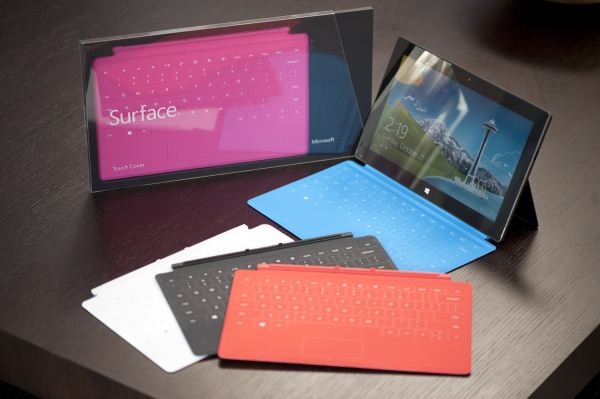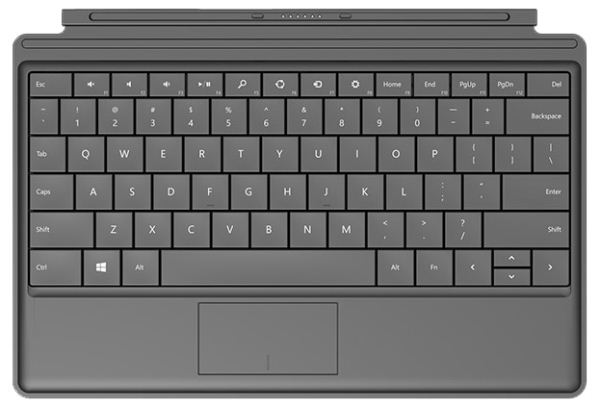Microsoft Surface Pro Review
by Anand Lal Shimpi on February 5, 2013 9:00 PM ESTTouch and Type Covers
Surface Pro features the same magnetic dock connector that Surface RT does. Unlike similar hybrid or convertible designs that came before it, Microsoft didn’t make the mistake of requiring a different set of docks for the Pro. All existing Touch and Type covers work perfectly with Surface Pro. Microsoft maintains that we will see other accessories that use this custom dock connector, even from third parties.
I already shared my thoughts on both covers in our Surface RT review so I won’t rehash all of that here. In short, the Touch Cover is probably one of the best tablet display covers I’ve ever used. It adds a marginal thickness (~3.3mm) to the tablet, but in exchange for the slight inconvenience you get a cover that you never have to remove and a keyboard that, albeit not perfect, is at least better than typing on a glass touchscreen.
The Type Cover is a bit thicker than the Touch Cover (~5mm) but you get real keys, which does wonders for improving the typing experience.
Both covers feature integrated trackpads, and neither is particularly great. Reaching out and touching the screen is a far better experience than trying to use the integrated trackpad for anything serious. Microsoft also offers a Surface styled wedge mouse, but I feel like having to carry around something else that’s not attached to Surface detracts from the whole tablet experience.
The more productivity focused nature of Surface Pro almost makes you want to use the Type Cover exclusively with the tablet though, whereas I felt the Touch Cover was the right pairing for Surface RT. You can obviously use either with Pro. As a writer I’m more likely to gravitate towards the Type Cover given its superior typing experience.
I’m beginning to wonder if there might be a fair amount of manufacturing variance between Touch Covers. If you remember back to my Surface RT review I mentioned that the Type Cover seemed to miss keystrokes. With my Surface Pro review unit Microsoft sent another Type Cover. This one seemed to miss fewer keystrokes than the original Type Cover I tested with. I originally surmised that missed keystrokes with the Type Cover might have been a performance issue, but with a full 17W Ivy Bridge under the hood of Surface Pro I don’t think that’s the case. Although Microsoft spent a great deal of time focusing on the build quality of Surface, I wonder if the same didn’t necessarily apply to the Type Cover.
Although the added thickness of the covers didn’t really bother me with Surface RT, I have to admit it did with Surface Pro. It’s all about perspective since the Surface Pro + Touch Cover is still thinner than most notebooks, but for a tablet it definitely doesn’t help Surface Pro feel any more svelte.
I wouldn’t give up either cover and I used Surface Pro with one attached at all times, this is just another plea for a thinner design - something I’m sure we’ll get with Surface 2.
This brings me to my next point, which is about the lack of any keyboard bundles with Surface Pro. Microsoft charges a hefty premium for both of its covers. Touch Cover will set you back $119 while Type Cover is $129. While I can logically justify the price tag of Surface Pro, you really need to add $120 - $130 on top of that because it doesn’t come with a physical keyboard of any type. Given the more content creation lean of Surface Pro, I’d like to see the $899 or $999 include a Type Cover. I understand that heavily eats into margins of a device that’s likely already pushing the limits given that it’s really at the forefront of a brand new tooling and manufacturing process for Microsoft, but it really has to be done. Perhaps once economies of scale kick in Microsoft might look into tossing in a free Type Cover.
Earlier I spoke about the issues with the kickstand while using Surface RT in your lap and how many of those same complaints apply to Surface Pro. The same is really true for the keyboard covers. While the kickstand + keyboard cover combination does a great job approximating a notebook when used on a desk, in your lap it’s a different story. The combination works, but it’s obviously not as rigid as a notebook. And you’re pretty much hopeless if you’re sitting in a funny position. Whereas you could cross your legs and still use a notebook in your lap, doing so with Surface Pro with kickstand and keyboard cover is far less manageable. And good luck trying to use Surface Pro as a notebook in your lap if both of your legs are crossed. The lack of rigidity in the connection between the keyboard and display combined with the fixed position kickstand can create some awkwardness. It’s all workable, but it becomes a lesser experience compared to a notebook. This is the Surface tradeoff.





















228 Comments
View All Comments
BSMonitor - Wednesday, February 6, 2013 - link
Because most people who are hardware reviewers see red flags only.. $899.. And the rest of the review is based on that..Surface Pro is the MOST productive tablet available. BY FAR. Why? because it's a PC in tablet form.
BSMonitor - Wednesday, February 6, 2013 - link
Has there been any talk/musings about a hybrid APU featuring both an Atom and the traditional Ivy Bridge/Haswell cores on a single die??I believe your last podcast mentioned the Octus or Octal or whatever in the ARM space. Seems like for a powerful, but mobile Surface Pro, this is a no brainer. If I want to switch to battery life mode and get 9-10 hours, Win 8 can be made to only schedule on the Atoms and power gate off Haswell.
Or does Intel really believe they can get Haswell and beyond into the power space of Atom/ARM??
dcianf - Wednesday, February 6, 2013 - link
The review said that in power saver mode it runs at 800MHz. Can you force the low clock rate? If so, how would performance and battery life compare to ARM?Netscorer - Wednesday, February 6, 2013 - link
That's actually a good point. Anand delivered performance charts based on fully powered core i5 and battery results based on clocked chip at 800MHz. Many people don't realize that you don't get both (and review does not help to highlight that difference) - either you are using it in light mode for stated hours or you run some complex program and have to be always connected because CPU would seep power like a thirsty kid on hot afternoon.marco89nish - Wednesday, February 6, 2013 - link
I also want to see how much battery life you can get on power saving mode. Peformance would also be nice, but it's predictable I guess, So, please, battery life on power saving mode. I registered to post this comment.smartypnt4 - Wednesday, February 6, 2013 - link
Anand, are you guys planning on reviewing the ASUS TAICHI21? The base model is $1300, which is only $170 more than the Surface Pro with a Type Cover, and it solves the lap usage problem while maintaining mostly the same battery life. I'll grant that it's a bit heavier, but I've got one and I absolutely love it. Those screens are just stunning.Beenthere - Wednesday, February 6, 2013 - link
That was just another scam by InHell.twotwotwo - Wednesday, February 6, 2013 - link
The Pro seems, in this and other reviews, to always get the unfavorable comparison on each dimension--it's not a thinner, lighter thin-and-light, it's either a heavy, bulky iPad or a bit slow for the most advanced games, depending on context.Microsoft seems to be betting that some folks can live with tradeoffs to get a super portable fully-functional computer. I really hope they're right; I'd like my next computer to be like this, and I'll have more options if this (or something like the Acer W700--I'd happily lose the pen and apparently unreliable covers) does well.
scsi stud - Wednesday, February 6, 2013 - link
Hi Anand,Would yod mind posting up a screenshot of the Surface Pro's desktop in full 1080p resolution? I'm curious to see how an application like Visual Studio 2012 would look like.
My hopes for this device were to be my go-to device for sitting on my couch writing code after I put my kids to sleep...
Thanks in advance.
spencer.p - Wednesday, February 6, 2013 - link
I am curious, Anand, if you can test to see if the Surface Pro works with the widi standard that Intel is pushing out and if it's also possible to get the Surface Pro to a 30" dual-link DVI monitor via one of those mini-displayport to dual-link DVI adapters. I am really curious if the Surface Pro will be able to meet my use case.